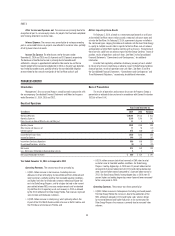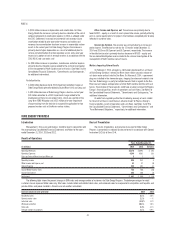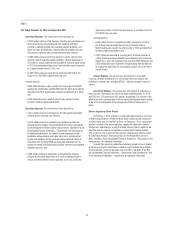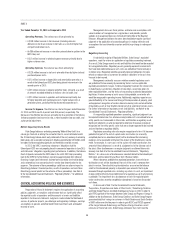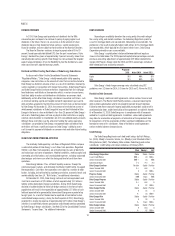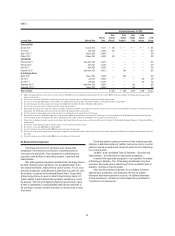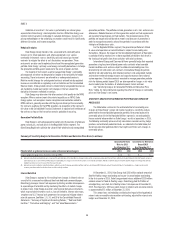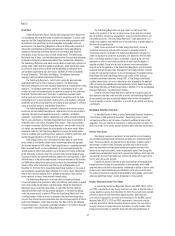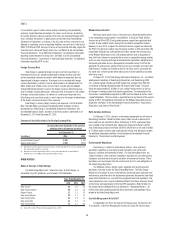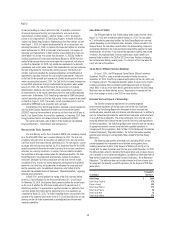Duke Energy 2014 Annual Report Download - page 69
Download and view the complete annual report
Please find page 69 of the 2014 Duke Energy annual report below. You can navigate through the pages in the report by either clicking on the pages listed below, or by using the keyword search tool below to find specific information within the annual report.
49
PART II
Duke Energy’s U.S. other post-retirement plan uses a health care trend rate covering both pre- and post-age 65 retired plan participants, which is comprised of a
medical care trend rate, which refl ects the near- and long-term expectation of increases in medical costs, and a prescription drug trend rate, which refl ects the near- and
long-term expectation of increases in prescription drug costs. As of December 31, 2014, the health care trend rate was 6.75 percent, trending down to 4.75 percent by 2023.
The following table presents the approximate effect on Duke Energy’s 2014 pretax other post-retirement expense and other post-retirement benefi t obligation if a 1 percentage
point change in the health care trend rate were to occur.
Other Post-Retirement Plans
(in millions) +1.0% -1.0%
Effect on 2014 other post-retirement expense $ 7 $ (6)
Effect on other post-retirement benefi t obligation at December 31, 2014 36 (31)
For further information, see Note 21 to the Consolidated Financial Statements, “Employee Benefi t Plans.”
LIQUIDITY AND CAPITAL RESOURCES
Sources and Uses of Cash
Duke Energy relies primarily upon cash fl ows from operations, debt
issuances and its existing cash and cash equivalents to fund its domestic
liquidity and capital requirements. Duke Energy’s capital requirements arise
primarily from capital and investment expenditures, repaying long-term debt and
paying dividends to shareholders. Duke Energy’s projected primary sources and
uses for the next three fi scal years are included in the table below.
(in millions) 2015 2016 2017
Uses:
Capital expenditures $ 7,025-7,425 $ 8,600-9,375 $ 7,050-7,825
Debt maturities and reduction in
short-term debt(a) 3,300 1,850 2,150
Dividend payments 2,250 2,300 2,350
Share repurchases 1,400 — —
Sources:
Cash fl ows from operations(b) $7,115 $ 7,525 $ 8,100
Debt issuances 3,100 6,000 4,000
Proceeds from the sale of
the Disposal Group 2,800 — —
(a) Excludes capital leases and securitized receivables maturities in 2016 and 2017 expected to be renewed.
Amounts represent Duke Energy’s fi nancing plan, which accelerates certain contractual maturities.
(b) Cash fl ows from operations includes expenditures related to ash basin closures.
Duke Energy expects the sale of the Disposal group to Dynegy to be
completed by the end of the second quarter of 2015. The sale price is $2.8
billion in cash subject to adjustments at closing for changes in working
capital and capital expenditures. Upon closing of the transaction, Duke Energy
intends to execute a balanced recapitalization strategy with the proceeds. The
recapitalization is expected to include a combination of an accelerated share
repurchase and debt reduction through avoidance of holding company debt
issuances in 2015. The ultimate use of proceeds will depend on facts and
circumstances at the time of the closing. For further information on the Midwest
Generation Exit, refer to Note 2 to the Consolidated Financial Statements,
“Acquisitions, Dispositions and Sales of Other Assets.”
In December 2014, Duke Energy declared a taxable dividend of historical
foreign earnings in the form of notes payable that will result in the repatriation
of approximately $2.7 billion of cash held and expected to be generated by
International Energy over a period of up to eight years. Between $1.2 billion
and $1.4 billion will be remitted in 2015, with the remaining amount remitted
by 2022. The proceeds of the dividend will principally be used to support Duke
Energy’s dividend and growth in the domestic business.
The Subsidiary Registrants generally maintain minimal cash balances and
use short-term borrowings to meet their working capital needs and other cash
requirements. The Subsidiary Registrants, excluding Progress Energy, support
their short-term borrowing needs through participation with Duke Energy and
certain of its other subsidiaries in a money pool arrangement. The companies
with short-term funds may provide short-term loans to affi liates participating
under this arrangement. See Note 6 to the Consolidated Financial Statements,
“Debt and Credit Facilities,” for additional discussion of the money pool
arrangement.
Duke Energy and the Subsidiary Registrants, excluding Progress Energy,
may also use short-term debt, including commercial paper and the money
pool, as a bridge to long-term debt fi nancings. The levels of borrowing may
vary signifi cantly over the course of the year due to the timing of long-term
debt fi nancings and the impact of fl uctuations in cash fl ows from operations.
From time to time, Duke Energy’s current liabilities exceed current assets
resulting from the use of short-term debt as a funding source to meet scheduled
maturities of long-term debt, as well as cash needs, which can fl uctuate due to
the seasonality of its business.
CREDIT FACILITIES AND REGISTRATION STATEMENTS
Master Credit Facility Summary
At December 31, 2014, Duke Energy had a Master Credit Facility with a
capacity of $6 billion. In January 2015, Duke Energy amended the Master Credit
Facility to increase its capacity to $7.5 billion through January 2020. The Duke
Energy Registrants, excluding Progress Energy, each have borrowing capacity
under the Master Credit Facility up to specifi ed sublimits for each borrower. Duke
Energy has the unilateral ability at any time to increase or decrease the borrowing
sublimits of each borrower, subject to a maximum sublimit for each borrower. The
amount available under the Master Credit Facility has been reduced to backstop
the issuances of commercial paper, certain letters of credit and variable-rate
demand tax-exempt bonds that may be put to the Duke Energy Registrants at the
option of the holder. The table below includes the current borrowing sublimits and
available capacity under the Master Credit Facility.



